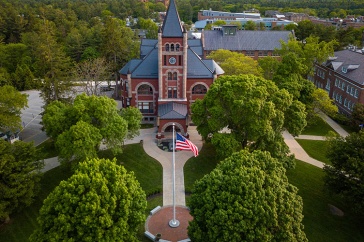
Thanksgiving’s arrival this week ushers in a month of holiday celebrations and a season of tables laden with some of the most delicious and decadent foods New England has to offer.
“Food is an important part of all celebrations,” says Joanne Curran-Celentano, professor of molecular, cellular and biomedical sciences. “Almost any holiday that is around family, you’ll find food."
Curran-Celentano and her colleagues Gale Carey, also a professor in the molecular, cellular and biomedical sciences department, and Julienne Guyette, lecturer and chef in the Thompson School of Applied Science, shared traditions from their individual areas of expertise around food, favorite expected — and unexpected — dishes to add to your holiday table and easy-to-implement ways to stay a little healthier this holiday season.
Curran-Celentano, who teaches NUTR 405 Food and Society, notes that some of those holiday traditions, including several around Thanksgiving, might not be as old as many of us believe.

“I tell NUTR 405 students of the invented holiday that really is more associated with Abraham Lincoln than the Pilgrims,” Curran-Celentano explains, referring to the 1863 proclamation that made Thanksgiving a national holiday. “The idea behind it was to create a tradition that would be uniquely American.”
And some of those most popular Thanksgiving side dishes are examples of how such traditions evolve. There is, of course, cranberry sauce and turkey, rarely seen at other times of the year except in aptly named “Thanksgiving” sandwich specialties. Then there’s sweet potato with marshmallow. Curran-Celentano notes marshmallows were transformed from luxury items in the 1800s as food technology evolved and allowed them to be produced inexpensively with such ingredients as gelatin and corn syrup. Another side dish on many a Thanksgiving table, the green bean casserole, only dates back to the mid-1950s, however, when it was born in the recipe development labs of Campbell’s Soup.
About that abundance...
Gale Carey’s courses include nutritional biochemistry, which examines such processes as the digestion and absorption of nutrients and evaluates nutrient requirements in the context of physiological and biochemical functions.

With food being front-and-center at holiday celebrations, “what becomes a challenge biochemically for the body is the abundance of food and the tendency to overeat,” Carey explains. To have a healthier holiday season, “Be mindful of portion sizes, when you are consuming foods and what you’re consuming.”
Food provides “a wonderful way to connect and bring people together and try dishes that might be new,” she says, adding, “The challenging thing for the body is that you don’t overload it with calories. What happens biochemically is any extra energy that comes into your body as food is going to be stored. Think of it as a supply and demand.”
But, she cautions, the holidays are not the time to get caught up in the idea of “bad” and “good” foods.
“Food should be enjoyed, and holidays are a wonderful time to do that,” she says. “There are so many things connected with food — traditions, socializing and comfort. You wouldn’t want to sacrifice that. It’s finding the right balance between what you’re taking in and the exercise you’re getting.”
Eat more kale?
Another key to keeping the holidays healthy is keeping them homemade.
“Prepare everything from scratch — those store-bought pie crusts and gravies contain more preservatives and unhealthy fats than if we prepared them freshly ourselves,” explains Julienne Guyette, whose courses include Culinary Nutrition, which focuses on basic nutrition and health concepts with an emphasis on healthy menu and recipe development.

the Barton Hall kitchen
For example, she adds, making pie crusts with butter results in “healthier and tastier crusts than those made with hydrogenated vegetable oils or shortening,” while for a pan gravy, poultry fat is a less saturated and more flavorful fat than butter.
“You can prepare a simple pan gravy from the drippings of the roast by adding flour to make a compound roux with mirepoix (onions, celery and carrots) and adding defatted poultry stock. This mixture is then pressed through a food mill, finished with fresh herbs to add richness and natural flavor to the pan gravy,” Guyette explains.
Are there any specific items she’d recommend for the holidays?
Get Chef Guyette’s recipe for Ginger Miso Kale Salad. See What's Cooking?
“Kale has finally been promoted from garnish status into full mainstream superfood vegetable acceptance,” Guyette notes. “Raw kale salads and juices have become popular, as has sautéed kale as a side dish or a stir-in to soups and casseroles.”
Adding sautéed kale or spinach to traditional Thanksgiving staples like stuffing will increase their nutritional value.
“Remember, too, as a general nutrition rule, at least half of your plate should be plants — vegetables, fruits, legumes, grains — so we are getting plenty of nutrients, like fiber, which fills us up longer, leaving us satisfied — and less likely to eat again sooner,” Guyette points out.
With so many post-harvest New England foods available, Curran-Celentano says, “Celebrate the harvest and use the solstice as a reminder that the sun will return and there will be another harvest.”

Want more about food? Read The Menu Makers to find out how UNH agricultural researchers have boosted Thanksgiving’s bounty
-
Written By:
Jennifer Saunders | Communications and Public Affairs | jennifer.saunders@unh.edu | 603-862-3585



















































